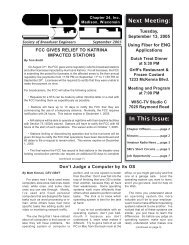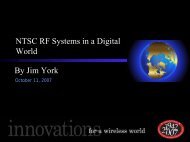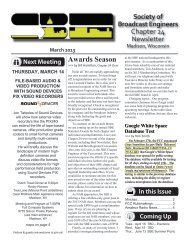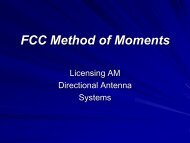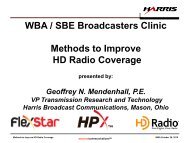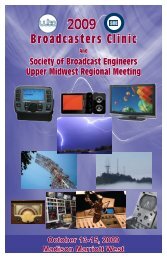E2X Transport Protocols - SBE Chapter 24
E2X Transport Protocols - SBE Chapter 24
E2X Transport Protocols - SBE Chapter 24
You also want an ePaper? Increase the reach of your titles
YUMPU automatically turns print PDFs into web optimized ePapers that Google loves.
<strong>E2X</strong> Link Reliability for<br />
HD Radio Systems<br />
Introducing a Reliable Real-Time Point-to-Multipoint <strong>E2X</strong> <strong>Transport</strong> Protocol<br />
Broadcasters Clinic 2007<br />
Madison, WI<br />
Jeff Welton<br />
Technical Sales Representative<br />
© Nautel Limited 2007
Overview<br />
Presentation Topics:<br />
• 2 nd vs. 3 rd Generation HD Radio Architecture<br />
• <strong>E2X</strong> Data Link Performance Requirements<br />
• <strong>E2X</strong> Synchronization<br />
• <strong>E2X</strong> <strong>Transport</strong> Requirements<br />
• A New <strong>E2X</strong> <strong>Transport</strong> Protocol:<br />
Nautel Reliable HD <strong>Transport</strong> Suite<br />
• Test Results<br />
• Application Examples<br />
• Conclusions<br />
2
Gen. 2 FM Architecture<br />
HDC<br />
Codec<br />
Exciter<br />
(New) Digital<br />
Transmitter<br />
Single AES<br />
Audio (Digital)<br />
Feed from STL<br />
ePAL<br />
EASU<br />
10 dB<br />
Comb.<br />
(Existing) Analog<br />
Exciter<br />
(Existing)<br />
Analog<br />
Transmitter<br />
Rej<br />
Load<br />
3
Gen 3 (Exgine) Terminology Review<br />
• Exporter – Linux-PC based component designed to encode<br />
and compress MPS audio at the studio and assemble a single<br />
HD data stream, called <strong>E2X</strong>, to send to the Exciter across the<br />
(Ethernet) STL. Also multiplexes Importer data into this stream.<br />
• Importer – Optional component, which encodes all AAS<br />
(Advanced Application Services) including Multi-channel<br />
audio, data services, etc., and sends I2E stream to Exporter.<br />
Normally located at studio end.<br />
4
Exgine Exciter<br />
•Exciter (Exgine)– Modulates and generates RF waveform<br />
for transmitter amplification. Accepts traditional inputs<br />
for the host FM audio, but only an Ethernet input for the<br />
HD Radio (<strong>E2X</strong>) stream.<br />
5
Exgine (Gen 3) Architecture<br />
6
Exgine STL Requirements<br />
Architecture requires 2 parallel functions for studio transmitter<br />
links:<br />
1. Analog FM Broadcast Audio link<br />
• normally 44.1kHz digital AES, may be dropped to 32kHz AES<br />
2. Digital Ethernet LAN STL for <strong>E2X</strong> protocol:<br />
• Data packet multiplexing with reliable delivery<br />
• Clock synchronization with predictable latency<br />
The two functions may be independent or integrated into a single<br />
product.<br />
7
STL is the Chokepoint<br />
• Must continue to carry analog signal<br />
• Bandwidth (throughput) is limited (200-500 kbps)<br />
• Most legacy STLs are unidirectional<br />
• Many operate in noisy or fade prone RF environments<br />
• STL traffic may contend with other data in addition to STL<br />
program<br />
8
<strong>E2X</strong> Performance Issues<br />
2 Symptoms of a less than optimum Exgine link:<br />
1. Dropouts in MPS audio channel<br />
– Loss of a single packet results in loss of entire frame (1.48 seconds<br />
of audio!)<br />
2. Inability to maintain consistent time alignment<br />
9
QoS Requirement<br />
Because the native <strong>E2X</strong> protocol is UDP, the QoS requirement is<br />
extremely high.<br />
Quality of Service (QoS) requirement:<br />
good on-air IBOC transmission<br />
total on-air IBOC transmission<br />
QoS of 99.999%:<br />
5E-11 BER for <strong>E2X</strong> transmission<br />
3E -7 BER for AES transmission<br />
QoS Packet Loss Effective BER MTBF<br />
99.999% 1 in 1.6 million 5 E-11 41.1 hours<br />
99.99% 1 in 160,000 5 E-10 4.1 hours<br />
99.2% 0.05% 4 E-8 3 minutes<br />
10
<strong>E2X</strong> Data Link Requirements<br />
Sources of <strong>E2X</strong> Dropouts<br />
• bit errors across STL<br />
• complete loss of STL connection<br />
• delayed packet delivery due to aggressor traffic<br />
• Large (22 kByte) packet can cause 600 ms delay on 300 kps link<br />
• insuffcient receive buffering on the exciter<br />
• link protocol collisions: IEEE 802.11 - 0.05% packet loss<br />
• packet discard due to congestion avoidance<br />
• packet discard on mixed speed networks<br />
Bottom Line; Some packet loss is a fact of life across Ethernet<br />
networks, and must be accounted for.<br />
11
<strong>E2X</strong> <strong>Transport</strong> Protocol Options<br />
• User Datagram Protocol (UDP)<br />
– Currently the default protocol<br />
– best effort delivery (no guarantees)<br />
– requires very reliable data link<br />
– Is used because it works on unidirectional STLs<br />
– Low bandwidth utilization (which is good)<br />
– allows point-to-multipoint streaming through IP broadcast or IP<br />
multicast IP address = (x.x.x.255)<br />
12
<strong>E2X</strong> <strong>Transport</strong> <strong>Protocols</strong><br />
• Transmission Control Protocol (TCP)<br />
– end-to-end reliable communciations using automatic repeat<br />
requests (ARQ)<br />
– addresses intermittent packet loss across STL<br />
– requires additional bandwidth overhead for re-transmission (up to<br />
40%)<br />
– introduces additional latency due to retransmission<br />
– limited to point-to-point connections<br />
– flow control can starve the exciter<br />
• high latency links<br />
• high packet loss<br />
13
<strong>E2X</strong> Synchronization<br />
1 Hz<br />
* sample rate<br />
PS<br />
eceiver<br />
audio<br />
sample<br />
rate<br />
N samples<br />
insert<br />
clock packets<br />
phase / frequency<br />
locked loop<br />
recovered<br />
processing<br />
rate<br />
udio feed<br />
asynchronous<br />
sample rate<br />
converter<br />
audio encoding<br />
digital processing<br />
create<br />
data packets<br />
c d c d c d c<br />
asynchronous transport link<br />
(Ethernet/IP)<br />
packet<br />
reception<br />
digital<br />
modulation<br />
• Basic timing derived from incoming audio sample rate (GPS locked)<br />
• Small clock packet every 92.8 ms<br />
• asynchronous link introduces clock jitter<br />
• Exciter is disciplined by clock packets<br />
1. lock transmitter processing rate to studio (within 1 ppm)<br />
2. establish a deterministic start-up time<br />
14
<strong>E2X</strong> Synchronization<br />
High Instantaneous <strong>E2X</strong> bandwidth (bursty) requirements<br />
• variable data packet sizes up to 19 kBytes<br />
• 600 ms congestion on 256kbps link<br />
• 19kB in 92.8 ms requires 1.5 Mbps link<br />
• Result = clock packet errors<br />
15
Control Packet<br />
•Exciter depends on Control Packet presence for startup<br />
•Without control packet system cannot restart properly<br />
•Prior to iBiquity rel 2.4.2 control packet was sent only once<br />
16
Best Networking Practices<br />
• Employ sub-netting and VLANs to segment traffic<br />
• Assign a high QoS to <strong>E2X</strong> stream data<br />
– Can configure routers and smart switches to do this<br />
– OR can include IP Precedence feature in protocol<br />
• Provision as much bandwidth as you have available (<br />
min. 300-500 kbps)<br />
• Do not mix device speeds (10/ 100 Mps)<br />
18
Worst Networking Practices<br />
Incorrect Network<br />
Topology<br />
IMPORTER<br />
EXPORTER<br />
STUDIO<br />
TRANSMITTER<br />
19
Sub-netting and VLANs<br />
Correct Network<br />
Topology<br />
Layer 2 Switch<br />
Layer 3 Router<br />
BUSINESS SUBNET<br />
AUTOMATION SUBNET<br />
HD RADIO SUBNET<br />
Exporter<br />
Business Traffic Automation<br />
STL STL<br />
Importer<br />
STUDIO<br />
TRANSMITTER<br />
20
Summary Requirements<br />
• Guaranteed delivery reliability of data packets<br />
• Recognize that data packets valuable only before modulation<br />
• Consistent on time delivery of clock packets<br />
• Don’t retransmit clock packets (a late clock is of no value)<br />
• Support for unidirectional and bidirectional STLs is required<br />
• Better support for point to multipoint applications<br />
• Support low bandwidth STLs (
A New <strong>E2X</strong> <strong>Transport</strong> Protocol<br />
Nautel introduces<br />
Reliable HD <strong>Transport</strong> Protocol<br />
<strong>E2X</strong><br />
TCP<br />
UDP IP Ethernet<br />
L7: Application Layer<br />
L6: Presentation Layer<br />
L5: Reliable Session HD Layer <strong>Transport</strong><br />
L4: <strong>Transport</strong> Layer<br />
L3: Network Layer<br />
L2: Data Link Layer<br />
L1: Physical Layer<br />
• periodic repeat for guaranteed<br />
delivery, including control packet<br />
• optional retransmission on lost data<br />
for limited guaranteed delivery<br />
• low latency transmission of clock<br />
packets<br />
• reliable point-to-multipoint<br />
communication<br />
• manages available STL bandwidth<br />
• allows traffic prioritization through<br />
IP precedence bits<br />
22
Optional Backhaul Channel<br />
Use LanLink or built in bidirectional capability of a T1 based STL<br />
23
A New <strong>E2X</strong> <strong>Transport</strong> Protocol<br />
<strong>E2X</strong> packet segmentation and reassembly<br />
<strong>24</strong>
A New <strong>E2X</strong> <strong>Transport</strong> Protocol<br />
Bandwidth Management<br />
2 parameters to configure system:<br />
1. total available link bandwidth dedicated to <strong>E2X</strong><br />
2. bandwidth to sustain new segment transmission<br />
25
Data Rebalancing Results<br />
Instantaneous bandwidth requirements are relaxed:<br />
• average bandwidth without re-transmission comparable to <strong>E2X</strong> specifications<br />
• low bandwidth overhead (around 8kbps)<br />
• multiple <strong>E2X</strong> connections can co-exist on the same link<br />
• can impact synchronization of another stream (around 5ms)<br />
• does not reduce receive buffer depth<br />
26
Clock Packet Tunneling Results<br />
Protocol induced clock packet jitter is removed:<br />
• consistent clock packet delivery<br />
• 700μs RMS jitter across simplex STLs (i.e. Moseley Starlink)<br />
• around 0.05 ppm frequency error<br />
• no separate GPS synchronization needed at exciter<br />
• provides consistent diversity delay (30-60μs)<br />
27
A New <strong>E2X</strong> <strong>Transport</strong> Protocol<br />
HD exciter<br />
exgine<br />
Exporter<br />
STL<br />
HD exciter<br />
exgine<br />
Basic Main / Hot-Standby Exciter:<br />
• all exciters produce IBOC signal<br />
simultaneously<br />
• exciters do not have to be co-located<br />
• applicable to N+1 transmitter configuration<br />
• applicable to multi-frequency networks<br />
• STL path can be made redundant<br />
28
Test Results<br />
<strong>E2X</strong> <strong>Transport</strong> Protocol Burst Error Tolerance<br />
• 2 cases exist:<br />
1. complete loss of link and packets are lost<br />
• packets must be re-transmitted<br />
• retransmission may only work after link is re-established<br />
2. congestion or loss of link and packets are delayed<br />
• can be absorbed in receive buffer<br />
• may introduce clock packet errors<br />
Buffer Depth<br />
(packets)<br />
Buffer Depth<br />
(seconds)<br />
Maximum<br />
Error Burst<br />
Max Aggressor<br />
Traffic (300 kbps)<br />
16 1.48s 200 ms 7.3 kB<br />
25 2.32s 600 ms 22.0 kB<br />
35 3.20s 1300 ms 47.6 kB<br />
50 4.64s 2100 ms 76.9 kB<br />
75 6.96s 3700 ms 135.5 kB<br />
Maximum link interruption across 300kbps link without HD dropout<br />
29
Test Results<br />
Lab Results<br />
Field Results<br />
KRCL Radio, Salt Lake City, Utah<br />
STL: Moseley Lanlink HD dropouts: 5 in 7 days<br />
Packet Loss: 0.7% MTBF: 1.4 days<br />
Effective BER: 1.7E-6 QoS: 99.9988%<br />
Avg. clock jitter: 32 ms Digital drift: 2.4 ms<br />
courtesy of Lewis Downey at KRCL<br />
30
Application Examples<br />
Remote Control<br />
Equipment<br />
HD Exciter<br />
Analog Exciter<br />
HD Exciter<br />
Analog Exciter<br />
LAN STL<br />
Simplex STL<br />
Simplex STL<br />
LAN STL<br />
Simplex STL<br />
Simplex STL<br />
Studio Monitoring<br />
Equipment<br />
Corporate LAN<br />
Exporter<br />
Exporter<br />
Co-located stations sharing one<br />
backhaul link for retransmissions<br />
EASU<br />
Importer<br />
Automation<br />
GPS<br />
EASU<br />
Importer<br />
Automation<br />
GPS<br />
Nautel reference design available that has been applied at<br />
KZWY and KYTI in Sheridan, Wyoming<br />
31
Application Examples<br />
Exporter<br />
satellite<br />
modem<br />
<strong>E2X</strong> Multicast<br />
QoS Queueing<br />
high priority<br />
low priority<br />
satellite<br />
modem<br />
satellite<br />
modem<br />
IGMP Join Request<br />
retransmit<br />
IGMP Join Request<br />
retransmit<br />
HD exciter<br />
exgine<br />
HD exciter<br />
exgine<br />
Satellite Distributed IBOC<br />
Multi-frequency Network<br />
• satellite modems (Radyne DMD20) provides QoS queuing<br />
• use IP multicast or broadcast to fan-out <strong>E2X</strong> protocol<br />
• one-way transmission delay around 125ms<br />
satellite<br />
modem<br />
IGMP Join Request<br />
retransmit<br />
HD exciter<br />
exgine<br />
32
Conclusions<br />
The Problem<br />
• STLs require a very low packet loss rate to minimize HD<br />
dropouts<br />
• Latency issues affect delivery of clock sync packets on time<br />
• Peak bandwidth requirements degrade performance<br />
The Solution: Nautel Reliable HD transport:<br />
• Addresses packet loss through retransmission more<br />
efficiently than TCP/IP<br />
• Addresses time alignment slippage through improved clock<br />
packet latency (Clock packet tunneling)<br />
• Performs data rebalancing and reduces instantaneous<br />
bandwidth requirements<br />
*patent pending<br />
33
Nautel Reliable HD <strong>Transport</strong> Suite<br />
– Nautel Reliable HD <strong>Transport</strong> Suite is available now as a<br />
low cost option on all Nautel HD systems<br />
– Can be configured for non-Nautel systems<br />
34
Contact Info<br />
Jeff Welton<br />
Technical Sales Representative<br />
NAUTEL<br />
(877) 662-8835, ext. 127<br />
jwelton@nautel.com<br />
Paper reference:<br />
<strong>E2X</strong> Bandwidth and Bit Error Requirements for Ethernet Synchronization<br />
Introducing a Reliable Real-Time Point-to-Multipoint <strong>E2X</strong> <strong>Transport</strong><br />
Protocol<br />
By Philipp Schmid<br />
NAUTEL<br />
Bangor, Maine<br />
35




